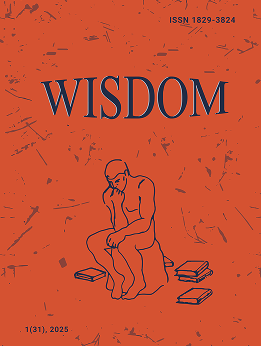Conceptual Model of a Smart Integrated Educational Environment
DOI:
https://doi.org/10.24234/wisdom.v4i3.911Keywords:
information-educational space, semantic modeling, digital repository, professional standard, educational standard, ontology, conceptAbstract
At present, we are witnessing a trend of gradual transition from traditional technologies of mass education to in-depth, practice-oriented training of professionals. In this regard, educational models based on the application of smart technologies for engineering information-educational spaces, which provide for the individualization of learning trajectories, flexibly combining the requirements of the employer with the possibilities of competence-oriented educational programs, are becoming increasingly important. The goal of the current study is to develop innovative educational programs of higher education through the integration of the components of the educational process into one information-educational space with the use of smart technologies, as well as to develop information search and logical-semantic algorithms for generating a variety of educational and methodological information, helping to form the most relevant educational and organizational and managerial content and organize the learning process under the predetermined parameters of specialist training in a particular subject area. As a result of the conducted research, the authors present their attempt at systematizing the variety of components of an information-education environment and conduct their ontological engineering in order to identify and subsequently integrate all components in the form of a global learning ontology.
Downloads
References
Barrasa, J., Hodler, A., & Webber, J. (2019). Knowledge graphs: Data in Context for responsive businesses. OíReilly Media.
Boichenko, A. V., Korneev, D. G., & Kazakov, V. A. (2015). Poisk dannykh, osnovannyi na semanticheskoi modeli (Data search based on a semantic model, in Russian). In Proceedings of the 18th Russian Scientific and Practical Conference ìInzhiniring predpriiatii i upravlenie znaniiamiî (pp. 123-132). Moscow: MESI.
DCMI (2012). Dublin Coreô Metadata Element Set, Version 1.1: Reference Description. Retrieved May 5, 2022, from http://dublincore.org/documents/dces/
DCMI (2020) DCMI Metadata Terms. Retrieved May 5, 2022, from http://dublincore.org/specifications/dublin-core/dcmi-terms/2020-01-20/
Gasparian, M. S. (2014). Razrabotka uchebnykh planov na osnove integrirovannogo informatsionno-obrazovatelnogo prostranstva (Curriculum development on the basis of integrated information-educational space, in Russian). Otkrytoe obrazovanie, 2, 51-58.
Gasparian, M. S., & Telnov, Yu. F. (2016). Podkhody k razrabotke sistemy inzhiniringa uchebnogo kontenta individualnoi sredy obucheniia (Approaches to developing a system of engineering the learning content of the individual learning environment, in Russian). In Proceedings of the 9th International Scientific and Practical Conference ìInnovative Development of Russian economyî. Innovation and the Russian economy in the context of global economic processes. Vol. 1. (pp: 19-21) Moscow: Plekhanov Russian University of Economics.
McLaughlin, M. (2015). Oracle database 11g PL/SQL programming. McGraw-Hill Osborne Media.
Telnov, Yu. F. (2014). Printsipy i metody semanticheskogo strukturirovaniia informatsionno-obrazovatelnogo prostranstva na osnove realizatsii ontologicheskogo podkhoda (Principles and methods of semantic structuring of information-educational space based on the implementation of the ontological approach, in Russian). Statistika i ekonomika, 1, 187-191. https://doi.org/10.21686/2500-3925-2014-1-187-191
Tikhomirova, N. V., Tikhomirov, V.P., Telnov, Yu.F., Maksimova, V.F. (2010). Integrirovannoe prostranstvo znanii ñ osnova integratsii obrazovatelnoi, nauchnoi i innovatsionnoi deiatelnosti vysshikh uchebnykh zavedenii (Integrated space of knowledge ñ the basis for the integration of educational, scientific, and innovative activities of higher educational institutions, in Russian). Professionalnyi uchebnik, 1-2, 8-11.
Telnov, Yu. F., Gasparian, M. S., Digo, S. M., Kazakov, V. A., Smirnova, G. N., Yaroshenko, E. V., & Trembach, V. M. (2015). Realizatsiia protsessov uchebno-metodicheskogo obespecheniia v integrirovannom informatsionno-obrazovatelnom prostranstve na osnove servisnoi arkhitektury (Implementation of educational and methodological support processes in an integrated information-educational space based on service architecture, in Russian). Statistika i ekonomika, 1, 198-206. https://doi.org/10.21686/2500-3925-2015-1-198-206 DOI: https://doi.org/10.21686/2500-3925-2015-1-198-206
Trembach, V. M. (2016). Inzhiniring intellektualnykh obuchaiushchikh sistem vuza (Engineering smart learning systems of higher education institution, in Russian). Statistika i ekonomika, 4, 64-67. doi: https://doi.org/10.21686/2500-3925-2016-4-64-67 DOI: https://doi.org/10.21686/2500-3925-2016-4-64-67
Weibel, S., Kunze, J., Lagoze, C., & Wolf, M. (1998). Dublin Core Metadata for Resource Discovery. Retrieved from https://datatracker.ietf.org/doc/rfc2413/ DOI: https://doi.org/10.17487/rfc2413
Zinder, E. Z. (2015a). Bazovye trebovaniia k informatsionno-obrazovatelnym prostranstvam, osnovannye na ikh fundamentalnykh svoistvakh (Basic requirements for information-educational spaces based on their fundamental properties, in Russian). Otkrytoe obrazovanie, 3, 83-94. DOI: https://doi.org/10.21686/1818-4243-2015-3(110-83-94
Zinder, E. Z. (2015b). Osnovaniia genezisa fundamentalnykh svoistv i bazovykh trebovanii k informatsionno-obrazovatelnym prostranstvam (Fundamentals of the genesis of fundamental properties and basic requirements for information-educational spaces, in Russian). Otkrytoe obrazovanie, 2, 46-55. DOI: https://doi.org/10.21686/1818-4243-2015-2(109-46-55
Downloads
Published
How to Cite
Issue
Section
License
Copyright (c) 2022 Mikhail GASPARIAN, Dmitry KORNEEV, Valery TITOV, Mikhail KARMANOV, Galina GOLKINA, Vladimir SEKERIN, Anna GOROKHOVA

This work is licensed under a Creative Commons Attribution-NonCommercial 4.0 International License.
Creative Commons Attribution-Non-Commercial (CC BY-NC). CC BY-NC allows users to copy and distribute the article, provided this is not done for commercial purposes. The users may adapt – remix, transform, and build upon the material giving appropriate credit, and providing a link to the license. The full details of the license are available at https://creativecommons.org/licenses/by-nc/4.0/.















